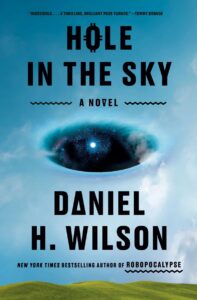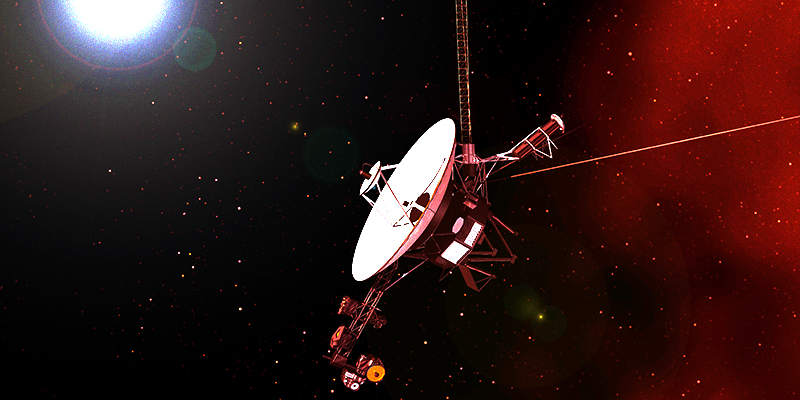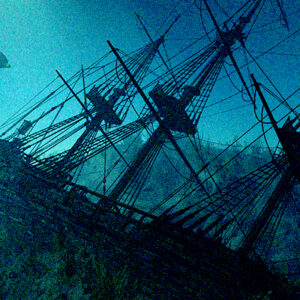They say to write what you know, and so a lot of my work has Oklahoma in it—Native characters, Native ways of thinking—and it also has a whole hell of a lot of robots. For my newest novel, Hole in the Sky, I went back home, to to tell a story of first contact with an alien entity, set largely where I grew up on tribal land in northeastern Oklahoma.
The novel follows NASA’s first observation of an interstellar anomaly, to its rapid approach, to its surprising impact near the town of Spiro—resulting in first contact. We bear witness through the lens of a by-the-books CIA weapons expert, an anti-social NASA astrophysicist, and a determined Cherokee father, haunted by the loss of his son and determined to make things right with his daughter. Together, these three people journey through earth and mind on an adventure with mortal consequences for all life on our planet.
I chose this group of three characters to explore how they react when they’re put face to face with the unknown in the form of an alien entity. Specifically, each character has a unique posture toward the unknown that I think is widely reflected in our society—the soldier wants to destroy it; the scientist wants to understand it; and the father has to accept the unknown and live with not being able to do either.
Lately, we’ve been confronted with an avalanche of new evidence of unidentified anomalous phenomena (collected by both civilians and the military). If some form of first contact is going to happen in our lifetime—what are our expectations as a society?
If some form of first contact is going to happen in our lifetime—what are our expectations as a society?Who is it that we think we’re going to meet?
The natural place to answer that question is to start with SETI, the Search for Extra-terrestrial Intelligence, right next door to NASA Ames in California.
NASA officially launched SETI on the 500th anniversary of Columbus’ first “voyage of discovery.” So it was literally founded on a settler mentality. And the goal of SETI is to find something called “civilization.” Specifically, an intelligent extraterrestrial civilization.
It’s a loaded term. Civilization means different things to different people. But to SETI it means they’re looking for things like industrial changes to atmospheric signatures on faraway planets; they’re looking for non-naturally occurring detritus or artifacts floating around where they shouldn’t be; and of course, most of all, they’re listening for random radio waves flying off into outer space.
Putting those objectives into English—what SETI is actually looking for is pollution, space junk, and old television shows beamed out into the cosmos. They’re looking for what our civilization is producing right now, and has been for seventy years or so. We are the one and only example of what SETI thinks it is looking for—an intelligent civilization.
We are looking into the stars and scanning them for our own reflection, and that mindset has permeated a lot of our scientific endeavors.
Consider the Fermi Paradox—the fundamental question that has long defined the scientific debate about finding extraterrestrial civilizations: Where is everybody?
A physicist named Frank Drake created an equation to predict the likelihood of intelligent civilizations emerging in our galaxy over time—and it predicted thousands and thousands. The assumption is that these aliens should have spread far and wide by now—yet we haven’t found evidence of them.
To help out, Nikola Kardashev created a taxonomy: Type 1 civilizations use a lot of the power of their star; type 2 civilizations can absorb every last drop of energy from their home star by wrapping it in something called a Dyson sphere; and type 3 civilizations have drained all the energy not only from their home star, but from their entire host galaxy.
Based on the Drake equation predicting so many aliens, and the Kardashev scale predicting their technological development, the sky should be teeming with advanced intelligent civilizations sucking up all the power of their suns and possibly whole chunks of the galaxy.
So, again, where is everybody?
People have been arguing about this for seventy five years. Some speculate that maybe there’s a Great Filter that kills intelligent life before it can spread. Or maybe a predatory species out there preying on budding civilizations. Or maybe the aliens are so advanced they’ve transcended matter and they don’t care about talking to us.
There’s another answer that occurs to me.
Maybe total galactic colonization, destruction of planetary environments, and complete extraction of resources is not the logical endpoint of an intelligent civilization? Maybe strip mining our home star and every resource in our solar system before moving on to pillage the rest of the galaxy should be labeled Type 0 civilization, instead of Type 3?
Pollution. Junk. Resource extraction. This is what we’re looking for. Fermi’s Paradox hinges on an assumption: that unchecked colonization is a self-evident fact of life for “civilization.”
And if you ask SETI why, they’ll say that’s because we have a sample size of one, for what a spacefaring intelligent civilization looks like. It’s us. But this is a fallacy. There are a lot of civilizations on this planet, present and past, that offer different perspectives.
I would argue that SETI is not looking for an intelligent civilization. A truly advanced intelligent civilization would have a balanced ecosystem. They would have no reason to encase their suns in Dyson spheres to absorb every photon or to expand like locusts between worlds. I’d argue that sustainability and locality are the hallmarks of intelligence.
So why are we looking for worlds on fire? I think it’s because science has trouble looking past that Western perspective—we can’t see past our own reflection.
We’re expecting to find a version of ourselves out there, but science is focusing on the wrong version of ourselves. On this planet, among all its people, there are other perspectives about what technology looks like, what the goals of a successful civilization should be, and who we might expect to find living among the stars.
Hole in the Sky looks past our own reflection to tell a story of first contact that I hope readers will find far more gripping, more strange, and more thoughtful than anything they’ve read before.
***

















